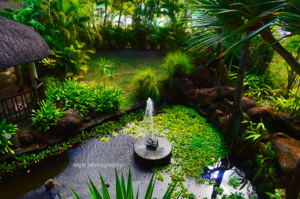
A restorative garden is a place where a person or group of persons can go to simply sit and be, to rejuvenate and to feel better by being in harmony with nature. It can also be called a healing garden. This type of garden usually involves having seating of some sort, so that people can sit down and observe the garden, the changing seasons, the visiting wildlife and insects and other things each individual will notice freely. It may also include gardening and garden-friendly activities, to help the people using it to get directly involved with nature and its surrounds as part of a restorative or healing process.
Making the restorative or healing garden[edit | edit source]
There is no one way to create a restorative garden but there are some key things to consider when creating one, as the emphasis needs to remain on it being restorative, uplifting, restful and calming. Thus, the sorts of things to keep in mind when turning a part of a garden or space into a restorative garden include:
- Choose a space that won't be intruded on by other activities, such as sports, people walking through, cars or other vehicles, etc. It's up to you whether the space includes the potential for other people to keep working on a veggie patch or similar––whether or not that seems calming and restorative will depend on the observer.
- Orient the garden so that wherever people sit, rest or stand, the view is pleasant and calming. This means doing your best to avoid views that include roads with frequent traffic, ugly edifices or disposal containers.
- As much as possible, choose a place that is quiet or where any traffic/street noise is at least muffled. Use plants, walls, containers, etc. to help further muffle noise from the outside.
- Attract wildlife and insects if this is beneficial to the garden. For example, grow plants that attract butterflies, bumblebees, birds, etc., as their visits provide additional peace and inspiration for the observer.
- Where possible, include water or a water feature. The sound and sight of water can be very calming for people.
- Provide shelter from the sun. This is especially important for the very young and the elderly and for any time spent in the garden during the height of a summer's day. You may also need to consider providing shelter from other elements such as wind and rain, depending on the intended time or season of use of the garden and its location.
- Use scent to encourage memories. This can be especially useful for the elderly or for the unwell who are spending time in the garden to relax and rejuvenate. Ensure that some flowers can be reached with ease for a good nose-in-flower experience.
- Encourage a tactile experience. Choose plants that are both safe and pleasant to touch and stroke. This can be a calming and communing experience for the participant.
- Don't neglect the power of actual gardening. Consider including a digging plot for those who find the act of gardening itself restorative. This can include tools for digging and planting, tools for watering and tools for harvesting flowers and edible results.
Non garden elements[edit | edit source]

Some things that can be lovely to include in a restorative garden aren't necessarily plants or typical garden features. Nevertheless, they can enhance the experience of spending time in the garden. For example:
- Consider including a meditative space. This could include a shrine, a spot sheltered from view, specialised garden elements such as a maze or a fountain.
- Include art in the restorative garden. This can be anything from statues and sculptures to handmade craft and repurposed objects.
- Include solar lighting for nights during summertime.
- Make an outdoor reading nook with shade for reading either books or e-readers. Include outdoor-proof cushions and other comfort items. You could even consider making it rain-safe so that the reader could spend time there on rainy days as much as in sunny weather.
- Include a tea/coffee corner. Have a little weatherproof nook for a kettle, tea/coffee, a few mugs and a solar heating element (or similar), to allow for drinks to be made in the garden. Encourage use of herbs suitable for teas by leaving laminated sheets explaining which herbs to use and how to make the herbal teas.
Making it comfortable[edit | edit source]

Add suitable items to enhance the experience of spending time in the garden contemplating, resting or sleeping. The following items can be helpful: Seating, cushions, lounge chairs, hammocks, logs and stumps, soft grass, earth mounds, a patch/field of scented flowers or chamomile lawn, etc.
See also the concept of the outdoor reading nook above.